Creation: Darwinian Evolutionary Frauds Pt. VII

A Sunday guest post by my brilliant husband, Gregg.
Every Sunday, my clever husband offers me a “day of rest” by writing posts on the subject of his primary ministry. This is a topic that is gaining more and more attention in our modern culture, Creationism vs. Darwinism, and is a subject that has broad reaching scientific, social, and metaphysical implications. As much as possible, these posts are written in layman’s terms, and in a format suitable for supplementing any homeschool curriculum whether you choose to believe the Biblical account — or secular guesses — about the origins of human life on earth.
Piltdown Man
In 1912, the amazing, final, and completely incontrovertible proof that human beings “evolved” from apes was discovered and presented to the world as Piltdown Man.
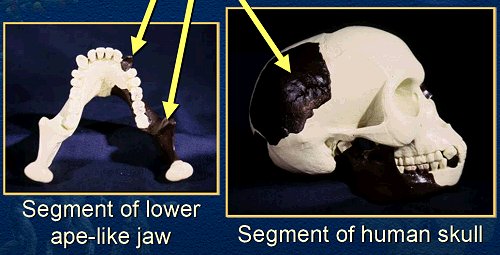 Piltdown Man created a sensation in both the world wide press and halls of science when announced by the British Geological Society. They gave it the authoritative and scientific sounding name, Eoanthropus Dawsoni. With a name like that, certainly we are in the presence of some great scientifically revealed truth, are we not? For 4 decades, the scientific world bowed before Piltdown Man as the great key to human evolution.
Piltdown Man created a sensation in both the world wide press and halls of science when announced by the British Geological Society. They gave it the authoritative and scientific sounding name, Eoanthropus Dawsoni. With a name like that, certainly we are in the presence of some great scientifically revealed truth, are we not? For 4 decades, the scientific world bowed before Piltdown Man as the great key to human evolution.
Only one, single, lonely, and rather incomplete specimen existed. As an aside, if the creature had actually existed for even a few hundreds of generations, logic dictates there should have been thousands of specimens and many in much more reliable condition.
Nevertheless, portraits were made of the GREAT MEN who found and worked on Piltdown Man; and three of those men were knighted by the king of England himself. The report by a dentist and contemporary of those men, made in 1916, who stated that the teeth had obviously been filed down by someone was utterly ignored. Such is the stuff of fame, personal aggrandizement, and secular humanism.
Finally, in 1953 and after nearly 40 years, Joseph Weiner and Kenneth Oakley applied the recently developed fluorine test to the bones—and found that Piltdown Man was a complete hoax. Someone had intentionally taken an ape jaw and combined it with a fragment of human skull bone, filed the teeth somewhat, and then carefully stained the entire “specimen” so that the bones looked both ancient and appeared to be a matching set. Then, imported mammalian fossils from South America and America along with contemporarily created handcrafted tools were placed nearby.
“Careful examination of the bone pieces [in 1953] revealed the startling information that the whole thing was a fabrication, a hoax perpetrated by Dawson, probably, to achieve recognition. The skulls were collections of pieces, some human and some not. One skull had a human skull cap but an ape lower jaw. The teeth had been filed and the front of the jaw broken off to obscure the simian [ape] origin. Some fragments used had been stained to hide the fact that the bones were not fossil, but fresh. In drilling into the bones, researchers obtained shavings rather than powder, as would be expected in truly fossilized bone.”—Harold G. Coffin, Creation: Accident or Design? (1961), p. 221.
It took 40 years to unravel the fraud. In hindsight, it should be patently obvious that revealing the fraud ran contrary to certain agendas. This is reinforced by the fact that Piltdown Man still appeared in textbooks without a hint of it being a complete hoax well into the 1960s.
The entire story of the Piltdown man fraud spans decades, and coupled with associated diagrams, drawings, and facts would require several thousand words to explain — even summarized. After all, entire books have been written about this single chapter in the Darwinist hall of shame. As such, the tale isn’t really suitable for a single, concise blog post. So,
I prayerfully considered many methods of delivering the information but I finally decided to put together the above summation followed by the detailed specifics in their entirety, for the record, and all in a single (if quite lengthy) post. It was a lot of writing. It is a lot of reading. It is a great deal to take in and to understand, and the tale has implications well outside of the facts of the specific case that echo throughout that time in the early part of the last century and ripple into the frauds perpetrated by Darwinists all the way into the present day. For these reasons, I concluded that it was worth recording here in one place.
For those who read no further, I pray you peace and God’s blessings.
Gregg
The Entire Story of Piltdown Man
Charles Dawson, a Sussex lawyer, was walking along a farm road close to Piltdown Common, Retching in Sussex, in England one day, when he stated that he “noticed that the road had been mended with some peculiar brown flints not usual in the district.” Upon inquiry, he said he was “astonished” to learn that they had been dug from a gravel bed on a farm.
He determined that he must go find where this “strange gravel” came from, although no one else in the community had ever considered the gravel to be strange in any sense of the word.
Relating the incident later in December 1912, Dawson said that particular walk on the road took place “several years ago.” This would put it in 1909 or 1910.
Many believe that none other than the imaginative inventor of the Sherlock Holmes detective mystery stories, notorious womanizer and drug user, and a confirmed atheist, Sir Arthur Conan Doyle, was involved along with Dawson in initially developing the idea for this fraudulent placement and later “discovery” of bones.
“Shortly afterwards,” Charles Dawson visited the gravel pit which he found located about halfway between Uckfield and Haywards Heath — interestingly enough, only a few miles from the mansion where Charles Darwin lived for most of his life — and found two men digging gravel. Unprovoked by any probable cause, Dawson asked the men if they had found any “bones or other fossils,” and they told him that they had not. He said that he then urged them to watch for such things, for they might find some in the future.
Not long after, he “just happened” to walk by the gravel pit again one morning — and was met by an excited workman who said that he found part of a skull in the gravel just after arriving at work! Describing it afterward, Dawson said that “it was a small portion of unusually thick parietal bone that looked as if it might be human and 300,000 years old.” This demonstrates the pure genius fo Dawson. After all, that was a lot of information to interpret based on a single glance.
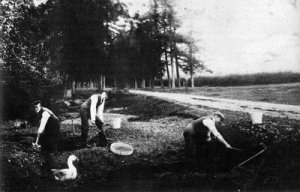 Mr. Dawson made a further search of the area, but could find nothing else in the gravel pit. It was not until “some years later,” in the autumn of 1911, on another visit to the spot, that Dawson found another and larger piece of bone. This time it was part of the frontal region of a skull, and included a portion of the ridge extending over the left eyebrow. He just happened to walk over to the gravel pit that day — and there it was, lying there with part of it exposed to the surface.
Mr. Dawson made a further search of the area, but could find nothing else in the gravel pit. It was not until “some years later,” in the autumn of 1911, on another visit to the spot, that Dawson found another and larger piece of bone. This time it was part of the frontal region of a skull, and included a portion of the ridge extending over the left eyebrow. He just happened to walk over to the gravel pit that day — and there it was, lying there with part of it exposed to the surface.
What a stroke of luck!
A short time thereafter, he just happened to have Dr. Arthur Smith Woodward, head of the Department of Geology at the British Museum of Natural History, with him on the day he found the all-important jawbone at the gravel pit. As Woodward looked on, Dawson dug down a few inches, and there it was! Again, what an uncanny stroke of luck.
This “magnificent discovery” came at just the right time. Both Charles Darwin and Thomas Huxley had died; and, although ” human fossil bones” had been dug up in various places in far countries, such as the Neanderthal, none of them were of much use to the cause since they were all clearly human.
What was needed was a half-million-year-old half-ape/half-human appearing skull and jawbone. And where better a place to find such old bones than in perpetually damp, boggy, swampy, murky, saturated England, where even bones a mere half a century old normally have already rotted back to bare elements and dust.
Woodward was an avid paleontologist, and had written many papers on fossil fish. Dawson and Woodward had many long talks together over the Piltdown bones.
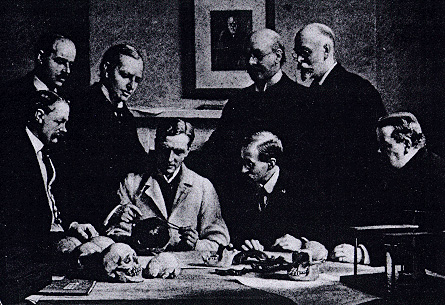 Then, Arthur Keith, an anatomist, was called in. Keith was one of the most highly respected scientists in England. Author of several classic works, he had all the credentials of respectability: a doctorate in medicine, Fellow of the Royal College of Surgeons, Fellow of the Royal Society, President of the Royal Anthropological Institute, and membership in the Anatomical Society and the British Association for the Advancement of Science.
Then, Arthur Keith, an anatomist, was called in. Keith was one of the most highly respected scientists in England. Author of several classic works, he had all the credentials of respectability: a doctorate in medicine, Fellow of the Royal College of Surgeons, Fellow of the Royal Society, President of the Royal Anthropological Institute, and membership in the Anatomical Society and the British Association for the Advancement of Science.
There was more talk. Then our old friend Grafton Elliot Smith, was brought into the circle. Thus was gathered together a team of scientists that was one of the most respected in the British Isles. The main subject of their penetrating conversations was a few bone fragments and a bunch of missing bones.
The lower jaw was too big for a human skull but, significantly, the upper jaw was entirely missing, and with it part of the lower jaw — and the important lower canine teeth. Also missing were the mating parts for the jaw hinge. That which was missing was exactly that which would have shown, first, whether or not the lower jaw, which was apelike, was from a human or an ape, and, second, whether the lower jaw fitted with the upper skull bones, which were obviously human.
The skull itself consisted only of several fragments. This meant that the size of the braincase could not be determined. The pieces might fit a larger braincase or a small one; there was no way of knowing. Keith, although an ardent Darwinist like the others, was more open to evidence, and theorized 1,500 cubic centimeters for the volume of the braincase; whereas Woodward thought it was only 1,070 (midway between an ape [600 cc.] and a modern human [averaging 1,800 cc.]). Keith’s estimate, which was slightly larger than some modern men, was made on the basis of the larger jaw. But his estimate angered the other men. Such an estimate would ruin a lot of planning and work.
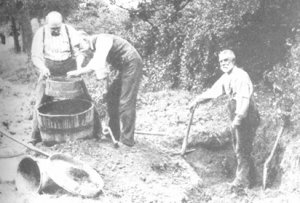 Then Teilhard de Chardin, an ardent Darwinist, although a Jesuit priest at a nearby seminary, found an apelike canine tooth in that gravel pit. Keith relented at this, and the men agreed on a brain capacity of 1,200 cc. With this miserly collection of a few bone fragments, the scientists “reconstructed” the entire head of what they proudly proclaimed to be “Piltdown Man.” Here at last, they triumphantly declared, was the “long-awaited MISSING LINK.”
Then Teilhard de Chardin, an ardent Darwinist, although a Jesuit priest at a nearby seminary, found an apelike canine tooth in that gravel pit. Keith relented at this, and the men agreed on a brain capacity of 1,200 cc. With this miserly collection of a few bone fragments, the scientists “reconstructed” the entire head of what they proudly proclaimed to be “Piltdown Man.” Here at last, they triumphantly declared, was the “long-awaited MISSING LINK.”
They declared it Eoanthropus Dawsoni, which stands for “Dawson’s Dawn Man.” That authoritative sounding Latin name made everything seem much more scientific.
On December 16, 1912, the discovery was officially announced at the Geological Society. The press went wild. Here was a sensation that would sell newspapers. Many people accepted it; many others did not.
Then, on August 29, 1913, Teilhard stayed overnight with Dawson and then went with him on yet another expedition the next day to the Piltdown pit. And there it was! By yet another miraculous stroke of luck, another of the two missing canine teeth was found! It was right there, not far under the gravel in the pit. Imagine that: just setting there, beautifully preserved for 300,000 years, washed by stream water and dampened by ages of British fog and rain, preserved as nicely as though buried in the Egyptian desert — just waiting for Dawson and Teilhard to find it. This was the crucial third piece of evidence and was duly reported at the 1913 meeting of the Geological Society.
Alongside that tooth was found a Stegodon tooth. The name Stegodon is the scientifically authoritative sounding name for ancestral elephants. That was helpful; for it provided evidence that the bones must indeed be very, very ancient.
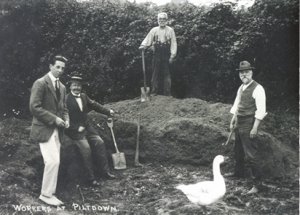 As an aside, scientists have recently analyzed that particular Stegodon tooth and found it to contain a high level of radioactivity from an ancient inflow of 0.1 percent uranium oxide into it. The radioactive level of the tooth was far too high for the British Isles, but equal to what one would expect to find in Stegodon teeth recovered from sites in the dry climate of lchkeul, Tunisia at that time. It just so happened that, from 1906 to 1908, Teilhard, an avid fossil collector for many years, had lived in North Africa and was known to have stayed for a time at Ichkeul near Bizerta in North Tunisia, a site where Stegodon fossils are plentiful. What a coincidence!
As an aside, scientists have recently analyzed that particular Stegodon tooth and found it to contain a high level of radioactivity from an ancient inflow of 0.1 percent uranium oxide into it. The radioactive level of the tooth was far too high for the British Isles, but equal to what one would expect to find in Stegodon teeth recovered from sites in the dry climate of lchkeul, Tunisia at that time. It just so happened that, from 1906 to 1908, Teilhard, an avid fossil collector for many years, had lived in North Africa and was known to have stayed for a time at Ichkeul near Bizerta in North Tunisia, a site where Stegodon fossils are plentiful. What a coincidence!
Even after the lucky second canine find, some non-Darwinian scientists argued that the jaw and skull did not belong to the same individual. It was also observed that the few skull pieces could be arranged into any number of shapes and sizes to match any desired braincase and head shape that might be desired.
In reality, that is exactly what had been done. The parts had been carefully selected, with consummate skill, to provide only certain evidence while omitting certain other facts. The objective was to reconstruct the head along ape lines afterward; for the nearer the “reconstruction” could be pushed toward the brute beast, the more convincing it would appear as “scientific evidence” of Darwinian evolution.
All the objections offered were tossed aside and given little attention in scientific societies, and even less in the public press. Human bones do not sell as many papers as half-human/half-ape bones sell. The actual bones were placed in the British Museum, in about the same location where today you will find a shrine to Charles Darwin, and plaster casts of the half-man/half-ape “reconstruction” were sent to museums all over the world.
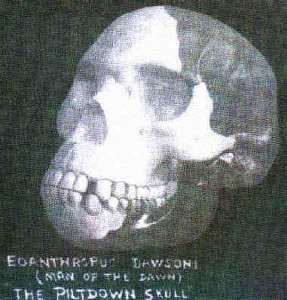 By August 1913, when the British Association for the Advancement of Science discussed the Piltdown bones. By another stroke of unbelievable luck, yet another molar tooth and two more nasal bones “had been found” in that same gravel pit.
By August 1913, when the British Association for the Advancement of Science discussed the Piltdown bones. By another stroke of unbelievable luck, yet another molar tooth and two more nasal bones “had been found” in that same gravel pit.
It was truly marvelous just how many pieces of bone kept showing up remarkably close to the surface of that magical gravel pit. In Piltdown Man,we have perfectly well-preserved bone specimens from 300,000 years in the past uncovered from that moist, dank, boggy gravel; whereas all the other millions of upon millions of bones of animals and men who had lived and died in that area during that supposed time span were nowhere to be found. The pit gave up that single set of skull pieces, jawbone, and teeth, and nothing more. And random chance had somehow ensured that they were very carefully broken, with only certain parts missing. And according to strata theory, the specimens should have all lain far below the surface, yet everything lay so close to the surface.
Where did that magical gravel come from? It is washed in from streambeds. No need for the perpetual dryness of desert sands to preserve bone. Rather, streambeds flowing in perpetually drenched England did just as well in preserving 300,000-year-old bones.
In their final reconstruction of the bones, the men located their solitary canine tooth on the right side of the lower jaw at an angle suggestive of an ape. That certainly helped. It does not take much to fool people, and the reconstructionists worked with a great deal of care and forethought. With a human skull and an ape skull jaw before them as they worked, they shaped the plaster to produce an “ape-man.”
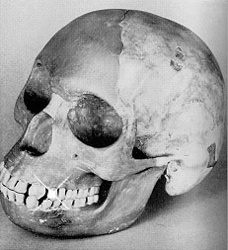 Captain St. Barbe and Major Marriott were two amateur paleontologists from Sussex who later reported that, on two separate occasions, they had surprised Dawson in his office and found him staining bones. Paleontologists know that the way to make bones look ancient is to stain them a darker color. Because of this, they suspected that his Piltdown bone finds were nothing more than artful fakes. Yet few would listen to the two men.
Captain St. Barbe and Major Marriott were two amateur paleontologists from Sussex who later reported that, on two separate occasions, they had surprised Dawson in his office and found him staining bones. Paleontologists know that the way to make bones look ancient is to stain them a darker color. Because of this, they suspected that his Piltdown bone finds were nothing more than artful fakes. Yet few would listen to the two men.
In 1915, Dawson sent Woodward a postcard announcing that he had found more fossils in a different gravel pit somewhere in the Piltdown area. To this day, no one has ever been told the exact location of that pit. But these new cranial bones, although even more fragmentary than the first ones, were with all due ceremony published by Woodward as “Piltdown II” finds in 1916, shortly after the death of Charles Dawson.
Then Came Four Disclosures
- W.K. Gregory, in 1914, and G.S. Miller, in 1915, announced in scientific journals that the “right lower” canine tooth — was in reality a left upper tooth. Scientists were not able to properly identify the only canine tooth in their possession; yet they were very definite in solemnly announcing that the Piltdown gravel was “in the main composed of Pliocene drift, probably reconstructed in the Pleistocene epoch.” They had less dexterity with teeth in hand than with their specific dates millions of years in the past.
- Another complaint came from Alex Hardlicka who, in the Smithsonian Report for 1913, declared that the jaw and the canine tooth belonged to a chimpanzee.
- A dental anatomist examined the teeth in 1916, and duly reported that the teeth had been filed. The file marks were quite obvious to see even without magnification. Keith and Woodward chose to ignore the report. They had good reason to ignore it.
- ln 1921, Sir Ray Lankester, maintained that the skull and jaw never belonged to the same creature. His conclusion was confirmed by David Waterston of the University of London, King’s College.
NOT ONE of the above four revelations ever reached the public press in any appreciable amount. A whole generation grew up with “Piltdown Man” as their purported ancestor. School textbooks, museum exhibits, public displays, encyclopedias — all spread the “good news” that man came from monkeys after all.
The Fame of Fraud
Oil paintings of the discoverers were commissioned and executed. The bones were named after Dawson, and the living men — Keith, Woodward, and Grafton — were knighted by British royalty for their part in the great discovery.
As for the bones of Piltdown Man, too many people were finding fault with them; so they were carefully placed under lock and key in the British Museum. Even such authorities as Louis Leakey were permitted to examine nothing better than plaster casts of the bones. The originals could reveal the fraud, the casts of them sufficiently hid the lie. As recently as 1946, the Encyclopedia Britannica (Vol. 14, p. 763) stated authoritatively, “Amongst British authorities there is agreement that the skull and jaw are parts of the same individual.”
Decades of deception passed, and then the whole thing finally blew apart.
The Hoax Uncovered
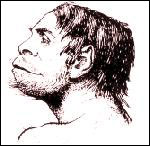
In 1953, a British Museum geologist named Kenneth Oakley, in collaboration with an Oxford University anthropologist named Joseph Weiner and a professor of anatomy at Oxford named Le Gros Clark, somehow managed to get their hands on those original bones. How they accomplished that is a remarkable story in its own right.
A new method for determining the relative age of bones by their fluorine content had been developed recently. To at least Clark’s surprise, the fluorine test revealed the bones to be quite recent. Additional examination revealed that the bones of Piltdown Man had been carefully stained with potassium bichromate in order to make them appear aged.
Drilling into the bone produced shavings, but should have produced powder if the bones had been ancient; but powder was not produced. Then that canine tooth was brought out — and found to have been filed, stained brown with potassium bichromate, and then packed full of grains of sand. Clearly, a lot of careful work had been done on those bones and teeth. No wonder it took so long before the discovery could be announced in the first place.
Sir Solly Zuckerman, an expert in the field, later commented that the person or persons who perpetrated this deliberate and unscrupulous fraud, knew more about ape bones than did the scientists at the British Museum.
The radioactive fluorine test is a method of determining whether several bones were buried at the same time or at different times. This is done by measuring the amount of fluorine they have absorbed from ground water. It cannot give ages in years, but is a sound method of establishing ages of bone samples relative to each other. The test showed that the skull fragments and the jawbones were separated by possibly up to a span of several centuries.
The House of Commons was so disturbed by the announcement of the fraud that it came close to passing a measure declaring “that the House has no confidence in the Trustees of the British Museum . . because of the tardiness of their discovery that the skull of the Piltdown man is a partial fake.”
“A member of the British Parliament proposed a vote of ‘no confidence’ in the scientific leadership of the British Museum. The motion failed to carry when another M.P. [member of Parliament] reminded his colleagues that politicians had ‘enough skeletons in their own closets.’ ” R. Milner, Encyclopedia of Evolution (1990), p. 364.
In 1955, Weiner, chief detective in the case, later published a book about the hoax, The Piltdown Forgery. He considered Dawson to have been the one who initiated the fake.
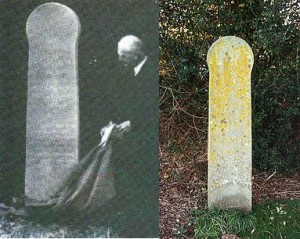
Adding to the embarrassment of a government and nation, three years before the exposé, the National Nature Conservancy had spent a sizeable amount of British taxpayers’ money transforming the area in and around the Piltdown pit into the Piltdown Gravel Pit National Monument.


I never realised where the Piltdown gravel pit was. A few years ago, I could have gone there quite easily; it would have been a few extra stops on the train that took me home from work. What a shame I’ve moved, I could have gone there with a plastic bone of my own!